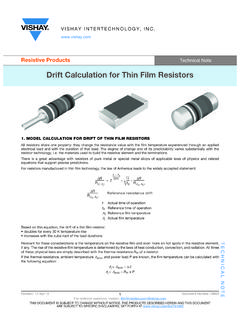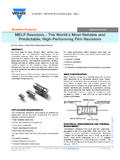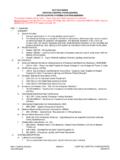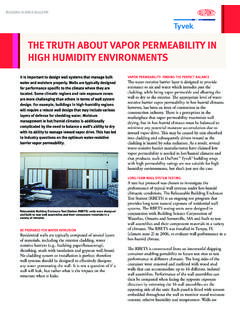Transcription of Resistive Products Thermal Management in …
1 Document Number: 28844 For technical questions, contact: 09-Feb-111 VISHAY BEYSCHLAGR esistive ProductsApplication NoteThermal Management inSurface-Mounted Resistor ApplicationsAPPLICATION NOTE1. INTRODUCTIONT hermal Management is becoming more important as thedensity of electronic components in modern printed circuitboards (PCBs), as well as the applied power, continues toincrease. Both factors lead to higher temperatures ofindividual components and of the entire , every electrical component in an assembly has tobe used within its prescribed operating temperature limitsdue to its material properties and reliability aspects. In thisapplication note, experimental results are provided in orderto prevent overheating of electronic devices such assurface-mount ELECTRICAL LOSS AND HEAT TRANSFERHeat is dissipated in the resistor by electrical loss (Jouleeffect), resulting in a temperature rise.
2 Once a temperaturegradient occurs, heat begins to flow. After a certain time(depending on the heat capacity and Thermal conductionproperties of the device) a steady-state condition will bereached. The constant heat flow rate PH corresponds to thedissipated electrical power Pel (Fig. 1).Since the nature of heat conduction through a body issimilar to Ohm s law for electrical conduction, theequation can be rewritten (see Heat Transfer Basics, nextpage):(1)where(2)is the Thermal resistance in the dimension of [K/W], whichcan be considered temperature independent for mostmaterials and temperature regimes of interest in electronicapplications. Fig. 1 Schematic illustration of the main heat flow path of a chip resistoron a Thermal Approximated Model of Thermal ResistanceHeat transfer in electronic devices such as surface-mountresistors on PCBs can be described by an approximatedmodel of the Thermal resistance.
3 Here, the direct heattransported from the resistor film to the surrounding air(ambient) by conduction through the lacquer coating and byfree air convection is neglected. Thus, heat propagates viathe alumina substrate, the metal chip contact, the solderjoint, and finally through the board (FR4 including coppercladding). The heat from the PCB is transferred to thesurrounding air by natural convection (Fig. 2).For simplification, the overall Thermal resistance RthFA canbe described as a series of Thermal resistors with thecorresponding temperatures at the interfaces as follows:(3)PH A 1 2 L-------------------------------- 1 2 Rth-------------------==RthL A-------=Pel = I2 RLacquerChipTop ContactSolderCu-LayerBottom ContactThin FilmBoardPH = /RthMain Heat Flow Path RthFARthFCRthCSRthSBRthBA+++= Thermal Management inSurface-Mounted Resistor Applications technical questions, contact: Number: 288442 Revision: 09-Feb-11 Application NoteVishay BeyschlagAPPLICATION NOTEThe respective Thermal resistance equivalent circuit isshown in Fig.
4 2 whereRthFC is the internal Thermal resistance of the resistorcomponent, including the resistor layer, the substrate, andthe bottom contact;RthCS is the Thermal resistance of the solder joint;RthSB is the Thermal resistance of the PCB, including landingpads, circuit paths, and base material;RthBA is the Thermal resistance of the heat transfer from thePCB surface to the ambient (surrounding air); andRthFA is the overall Thermal resistance from the resistor thinfilm to the ambient (surrounding air).The temperatures given for the nodes in the thermalresistance equivalent circuit are valid for the respectiveinterfaces: Film is the maximum thin-film temperature in the hot zone; Contact is the temperature at the interface between thebottom contact and the solder joint (valid for minimum sizesolder joints, otherwise certain parallel Thermal resistorsmight be introduced); Solder is the temperature at the interface between thesolder joint and the landing pad (PCB copper cladding); Board is the temperature of the PCB surface; and Ambient is the temperature of the surrounding air.
5 Fig. 2 Approximated Thermal resistance equivalent circuit of a chipresistor on a Heat Flow PathRthFCRthCSRthSBRthBAAmbientBoardSold erContactFilmRthFA HEAT TRANSFER BASICST hermal energy may be transferred by three basicmechanisms: Conduction, convection, and radiation.(4)ConductionThe heat flow rate for conduction is proportional to theone-dimensional gradient d /dx, where in thedimension of [W/mK] is the specific Thermal conductivity,and A is the cross-sectional area for the heat flux:(5)which has the dimension of [W]. For a simple cubic bodywith the length L and two parallel interfaces A at differenttemperatures, 1 and 2, the equation for the heattransfer is(6)ConvectionThe heat flow rate for convection can be describedsimilarly to equation (6),(7)where is the convective coefficient, A is the surfacearea at the temperature 1 of the object, and 2 is thetemperature of the surrounding fluid ( air).
6 Thecoefficient includes material properties of the fluid(heat capacity and viscosity) and conditions of fluidmovement (flow rate, forced/unforced convection, andgeometric shapes). Additionally, it also depends on thetemperature difference 1 - 2 itself. Thus, equation (7)looks simple, but for solving heat transfer problems, thecoefficient almost always has to be approximated ordetermined radiant flux can be described by theStefan-Boltzmann law (equation (8)), resulting in a netflux between two objects at different temperatures 1and 2 (equation (9)), assuming identical emissivity andsurface area. In(8)(9) is the emissivity, = x 10-8 Wm-2K-4 is theStefan-Boltzmann constant, and is the temperature ofa surface A. Nevertheless, heat transfer by radiationaccording to equation (5) will not be considered in thisapplication note, since the contribution is small at lowtemperatures.
7 Typically, more than 90 % of the total heatwill be dissipated by heat conduction. But, for infraredthermal imaging, equation (9) is of basic ++=PHConductiondQdt--------- Ad dx-------==PHConduction A 1 2 L-------------------=PHConvection A 1 2 =PHRadiation A 4=PHRadiation A 14 24 = Thermal Management inSurface-Mounted Resistor ApplicationsApplication NoteVishay BeyschlagAPPLICATION NOTE Document Number: 28844 For technical questions, contact: Internal Thermal ResistanceThe internal Thermal resistance RthFC is acomponent-specific value mainly determined by theceramic substrate (specific Thermal conductivity andgeometry). Solder Joint Thermal ResistanceFor conventional soldering, the Thermal resistance RthCS isnegligible due to a relatively high specific thermalconductivity of solder and a large ratio of cross-sectionalarea and length of flow path (approx.)
8 1 K/W). This is validespecially for a small stand-off. A larger solder joint can beconsidered as one Thermal resistor between the bottomcontact and an additional parallel Thermal resistor (from sidecontact to landing pad), enhancing Thermal conductionmarginally. Thus, we can approximate the overall thermalresistance of the component, including its solder joint:(12)Note that in case of improper soldering, the thermalresistance RthCS will lead to a higher overall thermalresistance. In particular, voids in the solder or insufficientsolder wetting might cause a significant contact thermalresistance or reduced cross-sectional areas of flow paths,and will lead to deteriorated Thermal Application-Specific Thermal ResistancesThe overall Thermal resistance RthFA includes the thermalcharacteristic of the resistor component itself and of thePCB, including its capability to dissipate heat to theenvironment.
9 The Thermal resistance solder-to-ambient,RthSA, strongly depends on the board design, which has atremendous influence on the total Thermal resistance RthFA(especially for extremely low component-specific RthFCvalues). The Thermal resistance board-to-ambient, RthBA,includes environmental conditions such as air for the choice of materials and dimensions isassigned to the circuit EXPERIMENTAL DETERMINATION OF Thermal Infrared Thermal ImagingInfrared Thermal imaging is widely used for thermalexperiments. In Fig. 6 an infrared Thermal image of a 0603chip resistor at 200 mW load at room temperature is maximum temperature in the center of the lacquer surfacecan be observed. The temperature of the solder joints isabout 10 K below the maximum temperature. A differentambient temperature will lead to a shift of the Determination of the Overall Thermal ResistanceThermal resistances can be determined by detecting themaximum film temperature as a function of dissipatedpower at steady-state condition.
10 For determination of theoverall Thermal resistance RthFA of an individual component,standard test PCBs (1) were used. The component in thecenter position was measured. Since equation (1) can berewritten to(13)a simple approximation leads directly to the thermalresistance RthFA = 250 K/W for a 0603 chip resistor (Fig. 4).Note(1)According to EN 140400, : FR4 base material100 mm x 65 mm x mm, 35 m Cu-layer, pad/circuit mm OF ELECTRICAL RESISTANCEAND Thermal RESISTANCEThe electrical current I passing through an electricalresistor R is proportional to the difference of the electricpotential U1 and U2:Fig. 3aThe heat flow rate P passing through a Thermal resistorRth is proportional to the temperature difference of 1and 2:Fig. 3bSimilar to electrical resistors, Thermal resistance of morethan one object in an assembly can be described bynetworks of series and parallel Thermal resistors, asshown for two Thermal resistors in the followingequations:(10)(11)U1 IRU21 PRth2 Rth (series)Rth1 Rth2+=1 Rth (parallel) 1 Rth1 1 Rth2 +=RthFSRthFCRthCSRthFC +=Rth Film Ambient PH-------------------------------------- -----= Thermal Management inSurface-Mounted Resistor Applications technical questions, contact: Number: 288444 Revision: 09-Feb-11 Application NoteVishay BeyschlagAPPLICATION NOTE Fig.






